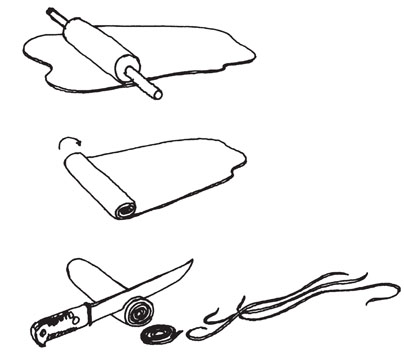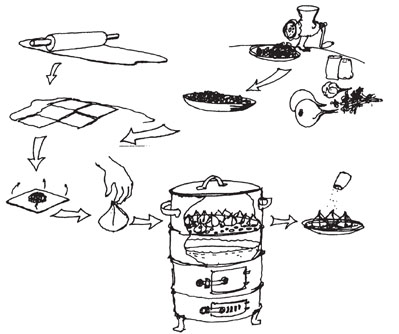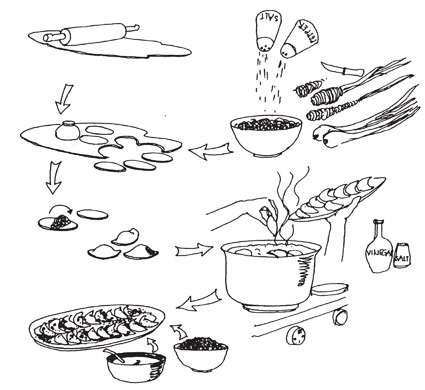Pasta and Noodle Dishes
Pasta and noodle dishes are popular in Afghanistan, especially in the north. They play an important part in the diet.
Pasta and noodle dishes have a long history and there are many theories about their origins. I subscribe to the view that the product evolved independently in more than one part of the world, especially the Orient and Italy. What is certain is that Afghan pasta dishes are very similar to those of neighbouring countries in Central Asia and of China. Mantu, a steamed pasta, is closely related to the Chinese bread, man t’ou, and the manti of Turkey. One could also say that some of the Afghan pastas are like some Italian forms: for example, ashak, a stuffed pasta, resembles ravioli to some extent and lakhchak is similar to lasagne.
To make Afghan pasta can take time, so many Afghans now living in the West substitute the wonton wrappers which are available in Chinese or Oriental supermarkets.
AUSH-E-ASLI
| Pasta, yoghurt and meatballs | serves 4 |
Aush is one of the well known and popular dishes. It is very versatile and families have their own variations. Afghans often prepare it to cure colds and then they add plenty of garlic and lots of red pepper as they say it helps clear the head and chest. It is filling and is usually eaten as a main course, but smaller quantities can be served as a first course. This recipe is for the original aush, known as aush-e-asli.
Afghans usually make their own spaghetti or noodles from the same dough used for boulanee (page 82). The dough is rolled out very thinly to 1.5 mm, then rolled up tightly and cut into fine strips with a sharp knife. The spaghetti is then tossed in a little flour and allowed to dry on a board. The spaghetti can be cooked straight away or stored in a covered jar for a couple of days. I have used fresh spaghetti, noodles or tagliatelle in this recipe as it saves time and fresh pasta is now available at many delicatessens and supermarkets.
225 g fresh spaghetti or tagliatelle
1 litre water, well salted
425 ml strained yoghurt
¼–½ tsp red pepper
2–3 cloves of garlic, peeled and crushed
1 tbs dried mint
for the meatballs:
450 g minced beef or lamb
1 medium onion, minced or grated
1 tsp ground coriander ♦ 1 tsp ground cumin
½ tsp ground black pepper and salt
1 egg (optional)
for the sauce:
75 ml vegetable oil
2 medium onions, finely chopped
110 g tomatoes, peeled and chopped
75 ml water
First of all prepare the meatballs. Combine the minced meat, onions, spices, egg and salt and mix thoroughly. Knead until smooth and form into small balls about 1 cm in diameter.
Now prepare the sauce. Heat the vegetable oil in a pan and add the onions. Fry, stirring continuously over a medium to high heat until soft and reddish-brown. Add the tomatoes, if used, and stir and fry briskly until the sauce turns brownish. Add the water, salt and pepper and bring back to simmering point. Add the meatballs, one at a time, in a single layer, then cover, leaving the lid slightly ajar, turn down the heat to low and simmer gently for about half an hour, or until the meatballs and sauce have a browned look and the sauce has thickened. If the sauce is too thick you can add a little water.
To cook the aush, put about 1 litre of water into a large pan and bring to the boil. Add plenty of salt and the spaghetti; bring back to the boil, then turn down the heat to medium and cook uncovered and gently for 10–15 minutes. Do not drain. Add the meatballs and sauce, the strained yoghurt, red pepper and the mint. Mix and stir well. Turn down the heat to low and leave to simmer slowly for about 10 minutes to let the flavours blend.
Meanwhile, fry the crushed garlic in a little oil and add to the aush, then serve, hot. Some Afghans like it very thick, others prefer a thinner soup and add extra water.
This dish can be prepared in advance and reheated.

Aush.
| Pasta with yoghurt, chickpeas, kidney beans and minced meat | serves 4 |
This is another version of aush which is also delicious. The recipe includes chickpeas and red kidney beans and, instead of the meatballs, minced meat is served separately and added on top of the aush.
50 g chickpeas
50 g red kidney beans
225 g fresh spaghetti or tagliatelle
425 ml strained yoghurt
salt
red pepper, according to taste
1 tbs dried mint
for the minced meat:
75 ml vegetable oil
2 medium onions, finely
450 g minced beef or lamb
150 ml tomato juice
1 tsp ground coriander ♦ salt and pepper
Soak the chickpeas and beans in water overnight. Put the chickpeas and red kidney beans into a large pan with the water in which they were soaked and add 150 ml of water. Bring to the boil, then reduce the heat and boil gently until cooked, adding extra water if necessary. Cooking time will vary according to the freshness of the pulses.
While the pulses are cooking, prepare the meat. Heat the oil in a pan over a medium to high heat. Add the chopped onions and fry, stirring continuously until they are reddish-brown. Add the meat and stir well. Fry until brown. Add the tomato juice and bring to the boil. Add the coriander, salt and pepper to taste. Stir again, then turn down the heat and simmer for about half an hour or until the meat is cooked. Add extra water if the mixture becomes too dry.
When the meat and pulses are cooked, bring to the boil 1 litre of water in a large pan. Add salt and the spaghetti or tagliatelle, and boil gently for about 10–15 minutes. Add the chickpeas, beans, strained yoghurt, and some or all of the juices from the peas and beans, depending on how thick you want the soup. Add the dried mint, salt and red pepper and mix well. More water can be added if required. Leave on a low heat for about 10 minutes or so to let the flavours blend. Serve the soup and top with a little of the meat. The remaining meat is served separately to be added to the top of each individual portion of aush.
This dish can be prepared in advance and reheated.
ASHAK
| Leek-filled pasta with meat sauce | serves 4, or 8 as a first course |
This delicious and famous pasta dish requires time and patience but the effort is well worth it. (Many Afghans, however, for quickness, now substitute wonton wrappers for the home-made dough.) In Afghanistan, the filling is gandana but leeks make a good substitute. It is usually served with minced meat and reconstituted quroot or chaka (strained yoghurt).
450 g plain white flour
1 tsp salt ♦ 1 egg
2 tbs vegetable oil ♦ 150 ml water
450 g washed, finely chopped gandana or leeks (trimmed weight)
½ tsp red pepper
2 litres water
425 ml strained yoghurt
3 cloves garlic, peeled and crushed
1 tsp vinegar ♦ 1 tbs chopped mint
for the meat sauce:
75 ml vegetable oil
1–2 medium onions, finely chopped
450 g minced beef or lamb
150 ml tomato juice or water
salt and black pepper
Ashak.
To prepare the dough, sift the flour and salt into a large mixing bowl, make a well and add the egg and 1 tablespoon of oil. Add the water slowly and knead thoroughly to form a smooth dough. Divide the dough into 2 balls and cover with a damp cloth for about an hour.
To prepare the meat sauce, heat the oil in a pan, add the onions and fry, stirring continuously, until they are reddish-brown. Add the meat, stir and fry until brown. Mix in the tomato juice or water and bring to the boil. Add salt and black pepper. Stir well, then lower the heat and simmer until the sauce is thick and oily (½–1 hour). Afghans like it oily but some of the oil can be spooned off.
Squeeze the gandana or leeks hard to drain, and place in a colander. Add 1 teaspoon of salt and the red pepper. Knead until the leeks begin to soften and then mix in the other tablespoon of oil.
Roll out one ball of the dough on to a lightly floured surface to a thickness of 1.5 mm — no thicker, or the ashak will be tough. Cut out rounds (6 cm diameter) with a cutter. Put 1–2 teaspoons of the drained leeks on half of the rounds. Use the other half to cover the leeks and seal the edges carefully. Place the prepared ashak on to a well-floured sheet or tray. Do not place on top of each other as they will stick together. Repeat with the remaining dough.
Place the strained yoghurt in a bowl and mix in the garlic and 1 teaspoon of salt. Put half of the strained yoghurt on a flat dish in a warm place.
Bring the water to the boil in a large pan and add the vinegar and 1 teaspoon of salt. Drop in the ashak and boil gently for about 10 minutes, pushing them down carefully with a slotted spoon as they rise to the surface. When cooked, remove with a large slotted spoon or sieve, taking care not to break them. Drain thoroughly and place the ashak on to the dish on top of the strained yoghurt. Cover with the remaining yoghurt and sprinkle over the mint. Top with a little of the minced meat and serve at once together with a separate bowl of meat.
MANTU
| Pasta filled with meat and onion | serves 4, or 8 as a first course |
This is the most traditional of all Uzbek dishes. I spent a very enjoyable day with the Rashidzada family, who kindly showed me how to make mantu. It is very tasty but does require some preparation. (To make preparation easier, many Afghans in the West substitute wonton wrappers instead of making the pasta.)
Uzbeks usually serve mantu as an appetizer and then follow it with a pilau, such as qabili pilau Uzbeki. You will need a large steamer for this recipe. Some people use minced meat to save time, but it works less well as the meat tends to form a hard lump inside the pasta.
Many Afghans like to serve mantu with a carrot qorma instead of the tomato sauce (see page 175).
450 g plain white flour
2 tsp salt
225 ml water
450 g boneless fatty lamb, chopped into very small pieces
450 g onions, finely chopped
1 green chilli pepper, finely chopped (optional)
1–2 tsp ground black pepper
1–2 tsp ground cumin
1 tbs vegetable oil
1 tbs tomato purée
1 tbs fresh coriander, finely chopped
425 ml strained yoghurt
Prepare the dough. Sift the flour with about 1 teaspoon salt into a mixing bowl. Add, slowly, as much water as required and mix to form a stiff dough. Place the dough on a clean work surface and knead for 5–10 minutes or until the dough is elastic and shiny. Form the dough into a ball, cover with a damp cloth and set aside for about an hour.
Put the chopped lamb, onions, chilli, 1 teaspoon salt, pepper and spices in a bowl and mix thoroughly.
Divide the dough into 4 small balls: this will make it easier to roll out. Roll out to a thickness of about 1.5 mm on a lightly floured surface. Cut into 10 cm squares. Into each square put about 1 heaped tablespoon of meat mixture. Take two opposite corners and bring them to join in the centre by nipping together firmly between your fingers. Nip together the two remaining corners as shown in the diagram. The mantu should not be sealed completely as the steam has to be able to penetrate and cook the filling. The method of sealing them varies but I have found this way to be the simplest. Use fat to grease well the shelves of the steamer. This prevents the mantu from sticking. Place them on the shelves leaving a small space between each one. Steam for 30–45 minutes over a medium heat.
While the mantu are steaming, make the tomato sauce (or carrot qorma if preferred). Heat the oil in a pan, add the tomato purée and bring to the boil. Turn down the heat, stir and simmer until the mantu are ready.
Remove the mantu carefully from the steamer shelves and place on a large, warm dish. Spoon the tomato sauce over the top and sprinkle with the chopped coriander. Serve the strained yoghurt in a separate bowl.

Mantu.
| Afghan lasagne | serves 4 to 6 |
Lakhchak is a little similar to Italian lasagne. It is simple to make, especially if you buy ready-made fresh lasagne. Alternatively, make the same dough as for ashak (page 93) or for boulanee (page 82).
for the meat sauce:
75 ml vegetable oil
2 medium onions, chopped
450 g minced beef or lamb
150 ml water or tomato juice
1 tsp ground coriander
salt and pepper
for the lakhchak:
425 ml strained yoghurt
2–3 cloves of garlic, peeled and crushed
salt
450 g fresh lakhchak or lasagne
1–2 tbs olive oil
or corn oil 1 tbs dried mint
Cook the meat as in the recipe for aush, above.
Add the peeled and crushed garlic and a little salt to the strained yoghurt.
Cut the lakhchak into 5 cm squares, or into any shape you wish. (Do not make the shapes too big or they will be difficult to handle.) If you are making your own home-made dough, roll it out thinly, to about 1.5 mm and cut into shapes.
Boil plenty of salted water in a large pan and add 1–2 tablespoons of oil. (This helps prevent the lakhchak sticking together.) Add the lakhchak one at a time to the boiling water and cook for 10–12 minutes. If you cannot cook the lakhchak all in one go, cook half and keep them warm while cooking the second batch.
Spoon about one third of the strained yoghurt on to a large, warm dish, then add half of the cooked lakhchak. Spoon another third of the yoghurt over the top and cover with half of the meat sauce. Sprinkle with a little of the mint. Add the rest of the lakhchak, cover with the remaining yoghurt and remaining meat sauce. Sprinkle with the remaining mint. Serve immediately.
VARIATION. Some Afghans fry chopped gandana (but you can use leeks) in a little oil and put them between the lakhchak – 225–450 g of leeks are enough.
